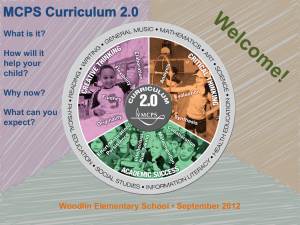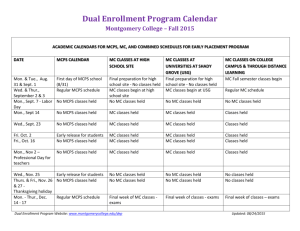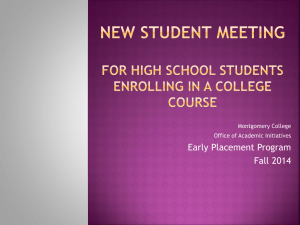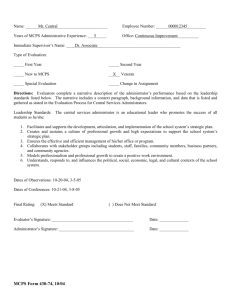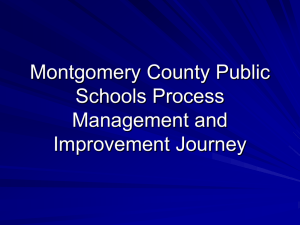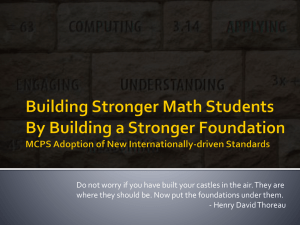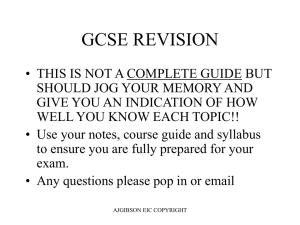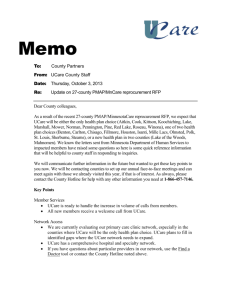Building A Stronger Math Program By Building a Stronger
advertisement
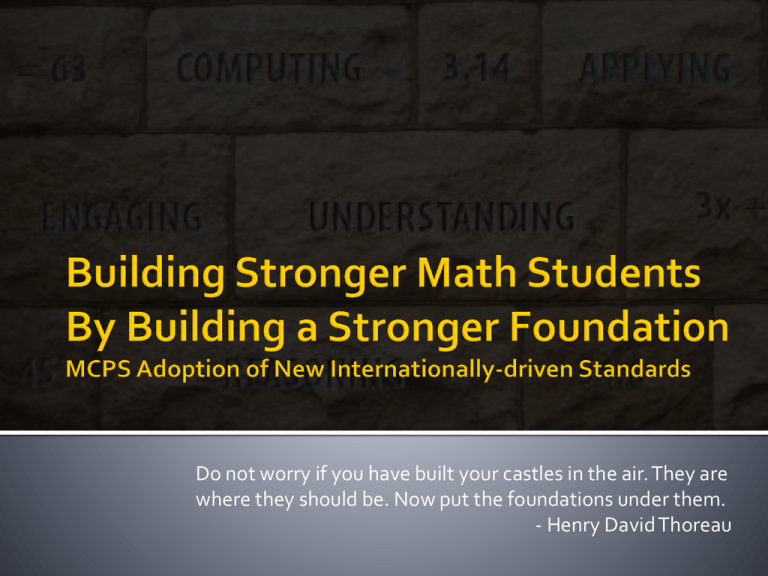
Do not worry if you have built your castles in the air. They are where they should be. Now put the foundations under them. - Henry David Thoreau Do you consider yourself a “math person?” Do you consider yourself a reader? Develop students who love math and see it as sensible and useful to solving problems and making sense of the world. All students will reach proficiency in math – Understanding, Computing, Applying, Reasoning, and Engaging (UCARE). 2000 Rank 2003 Rank 2006 Rank (out of 26) (out of 26) (out of 26) 2009 Rank (out of 26) Math 17th 22nd 22nd Tied 20th Science 13th Tied for 17th 19th 13th n/a Tied 10th Subject Reading 14th 14th Rankings are for the 26 OECD countries participating in PISA in 2000, 2003, and 2006. Slide Credit: EdTrust.org Data Source: Organization for Economic Cooperation and Development (OECD), PISA 2006 Results, http://www.oecd.org/ 550 2003 PISA - Math OECD Average U.S.A. 500 450 400 350 300 Slide Credit: EdTrust.org Data Source: Organization for Economic Cooperation and Development (OECD), PISA 2006 Results, http://www.oecd.org/ China has not taken PISA as a nation. Certain cities such as Shanghai have joined and are ranking near the top. Finland Korea Netherlands Switzerland Canada Japan New Zealand Belgium Australia The Common Core State Standards: Include rigorous content and application of knowledge through high-order skills Build upon strengths and lessons of current state standards Internationally benchmarked so that all students are prepared to succeed in our global economy and society Based on evidence and research Learn more: http://www.corestandards.org/ These four nations are in the top ten U.S.A. Source: OECD, PISA 2006 Results, table 4.2c, http://www.oecd.org/ 600 550 500 450 400 350 300 Source: Organization for Economic Cooperation and Development (OECD), PISA 2003 Results, data available at http://www.oecd.org/ U.S.A. 2001 MCPS CCSS/EIC Rigor ✔ ✔ Coherence ✔ ✔ Focus ✔ refers to the degree that sets of standards address key content that prepare students for success beyond high school. 2001 MCPS CCSS/EIC Rigor ✔ ✔ Coherence ✔ ✔ Focus ✔ refers to whether the standards create an appropriate balance among: conceptual understanding procedural skill problem solving with an emphasis on application and modeling Percent of Content 2001 MCPS Curriculum Number Algebra Geometry Measurement Statistics Math Math Math Math Math Math Math Math Alg. K 1 2 3 4 5 6 7 Prep Probability Percent of Content Final Common Core Standards Math Math Math Math Math Math Math Math Math K 1 2 3 4 5 6 7 8 Number Algebra Geometry Measurement Statistics Probability The CCSS recommend that elementary schools focus on building a strong foundation in number concepts – before accelerating into advanced math. MCPS Math teachers in advanced level courses in middle school and high school have requested a stronger foundation in number concepts for ALL students, even the most advanced. Going Deep in Mathematics 2001 Curriculum and CCSS Comprehending Concepts, Operations, & Relations Understanding Seeing math as sensible, useful, and doable Carrying out procedures Computing Engaging Applying Reasoning Formulating and solving mathematical problems Using logic to explain a solution Math 2.0 Video 1½ ÷ ½ = a. b. c. d. ½ ¾ 3 1 Write this problem as a question using words and not symbols. 3 2 3 2 1 How many halves are in one and one half? 1½ ÷ ½ = 3 Describe a situation requiring use of this concept. You have a yard and a half of ribbon to make bows. Each bow requires ½ yard. How many bows can you make? Complete the number sentence with <, >, or = 352 < 360 114 > 113 When might we need to compare three digit numbers? Which type of milk will give you the most energy per serving? Reduced Fat Milk Chocolate Milk Milk Whole Milk Fat Free How is teaching math for UCARE – depth proficiency different than how you learned math? Questions about what has been presented so far? Coming up next: Differences between the 2001 MCPS curriculum and EIC Acceleration and Enrichment State and local assessments What Makes The EIC Foundation Stronger? MCPS 2001 Curriculum Framework EIC / Internationally-driven standards “Spiral” Curriculum – concepts introduced and mastered over several grade levels Concept introduced and mastered in one grade level Grade level standards not sufficiently challenging for most students Many standards are “pulled down” from upper grades. Language of standards was general and not specific – resulting in teaching to test. Fewer, higher, clearer standards provide direction for teaching and learning – not testing. Curriculum developed independently of all other subjects Curriculum integrated with other content areas and thinking and academic skills Comparing Standards on One Topic in Grade 2: Using Place Value to Add and Subtract MCPS 2001 Curriculum EIC / Internationally-driven standards • Add and subtract two- and three-digit numbers using alternative strategies. • Add two- and three-digit numbers with regrouping. • Subtract two-and three-digit numbers with regrouping. * • Model and use the identity and commutative properties for addition…to solve problems. * * From a higher grade level • Add and subtract within 1000, using concrete models or drawings and strategies based on place value, properties of operations, and/or the relationship between addition and subtraction; relate the strategy to a written method. Understand that in adding or subtracting three digit numbers, one adds or subtracts hundreds and hundreds, tens and tens, ones and ones; and sometimes it is necessary to compose or decompose tens or hundreds. • Mentally add 10 or 100 to a given number 100–900, and mentally subtract 10 or 100 from a given number 100– 900. • Explain why addition and subtraction strategies work, using place value and the properties of operations. Critical Questions For Instructional Planning 1. 2. 3. 4. What do students need to know and be able to do? How will we know they have learned it? What will we do when they haven’t? What will we do when they already know it? Enriched and Accelerated Instruction in Elementary Math All Students – In the grade level EIC/CCSS Curriculum • Grade level expectations are at a higher level • Fewer topics per grade level • Enrichment–mastery of the 5 UCARE strands requires greater depth for all students Many Students – who consistently master all five • Additional - Who consistently UCARE strands Enrichment demonstrate strong for a topic • MCPS mastery in all five Acceleration strands for an indicator in mastered Few Students – grade topics level advancement Number & Counting & Operations and Operations Cardinality Algebraic Thinking Base Ten Foundations for place value: numbers 11-19 are ten ones and some more ones (KMP4) Foundations for place value: Ten ones is a unit called a “ten” Tens can be counted (G1MP1) Addition – putting together and adding to problems within 10. Subtraction – taking apart and taking from problems within 10 (KMP4) Decompose numbers less than or equal to 10 into pairs in more than one way (KMP2) Addition and subtraction problems unknowns in all positions within 10 (G1MP1) Decompose numbers less than or equal to 10 into more than two parts (KMP2) Know number names and the count sequence to 100 (KMP1) UCARE Enrichment Apply place value concepts: Extend counting sequence to 120 starting at any number (G1MP1) Decompose numbers less than or equal to 20 into pairs in more than one way (KMP2) Count to tell the number of objects Compare numbers (KMP2) Learning Progression Enrichment Fluency within 5 (KMP4) Count forward from a given number Compare numbers (KMP4) Learning Progression Acceleration No reporting of above, on, or below grade level. Now use “advanced, proficient, or basic” to describe students. Advanced: Consistently has complete understanding of the grade level content Proficient: Demonstrates understanding of most grade level content Basic: Demonstrates minimal understanding of grade level content. Maryland joined a consortium of states to develop assessments that measure the Common Core State Standards. It is expected that the PARCC assessments will be incorporated into, and eventually replace MSA. MCPS will pilot the MAP-P (K–2) and MAP-M (3–5) to augment the school’s assessments and to provide a national comparison. At Woodlin we are currently using the MAP-P in grades K and 1. MCPS is also working with the state to see how state assessments may replace MAP-M when they come online. Projected PARCC Assessment Development and EIC Implementation Timeline School Year PARCC Assessment Timeline 2011-2012 Item and Task Development K 1 2* 2012-2013 Development/ Field Testing 1 2 3 2 3 4 New Summative Assessment In Use 3 4 5 2013-2014 2014-2015 * Voluntary for Non-OARS Schools CCSS/EIC Implementation Enrichment and Acceleration Implementation Plan School Year 2011-2012 School Year 2012-2013 Kindergarten, Grade 1, Grade 2 Grade 3, Grade 4, Grade 5 Common Core State Standards/ Elementary Integrated Curriculum Grade Level Math Curriculum with enrichment and acceleration MCPS 2001 Curriculum Continue acceleration within grade level and next grade level up Kindergarten, Grade 1, Grade 2, Grade 3 Common Core State Standards/ Elementary Integrated Curriculum Grade Level Math Curriculum with enrichment and acceleration Grade 4, Grade 5 MCPS 2001 Curriculum Continue acceleration within grade level and next grade level up Weekly planning Seatwork is differentiated when our topics lend itself to differentiation. Our math homework has a menu and the paper is not differentiated, however the "hands-on" activity is open ended. Groups are flexible and reflect student mastery. • Most classes have 3 groups and the content in each of the 3 groups is different. • The differentiation is occurring in the “whole group” lesson (which is delivered in a small group setting since we have 3 groups and must deliver 3 different whole group lessons) and in the follow-up. Seatwork is differentiated based on the concepts we are working on specifically with the students. • For example, if one group is decomposing numbers with 3 parts and another group is still working on counting on from a number other than 0/1, the follow-up tasks would reflect this difference. Homework • Math menu for families to choose from. • The tasks are open-ended What Does Grouping Have to Do With This? Grouping decisions made schools to best meet the All Students – In theare grade levelby EIC/CCSS Curriculum needs of students. (MCPS IHB-RA) Grouping must be flexible and changes as students needs change. (MCPS IHB-RA) - Who consistently A balance needs to be achieved so highly able students demonstrate strong mastery in all five have the opportunity to work in homogenous groups, strands for an indicator heterogeneous groups, and individually depending on the content area and task involved (MCPS IOA)
